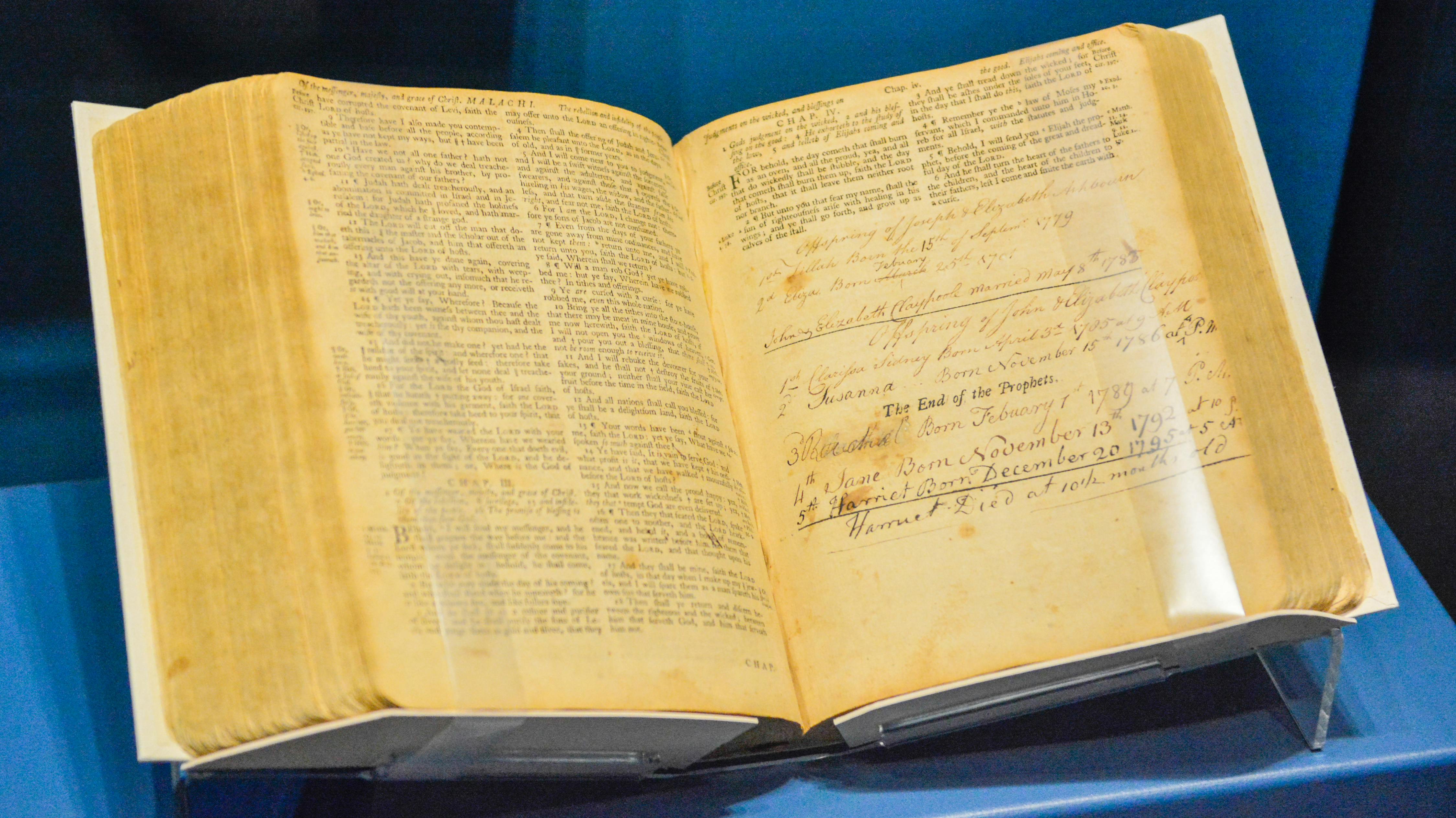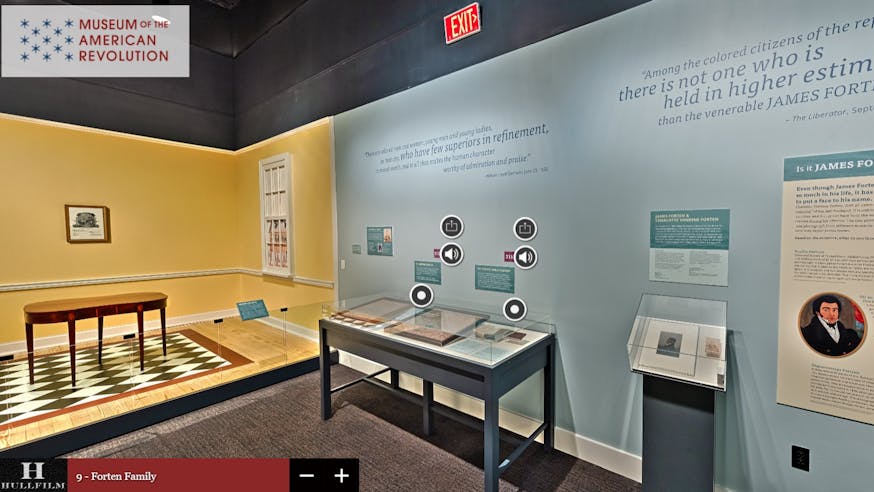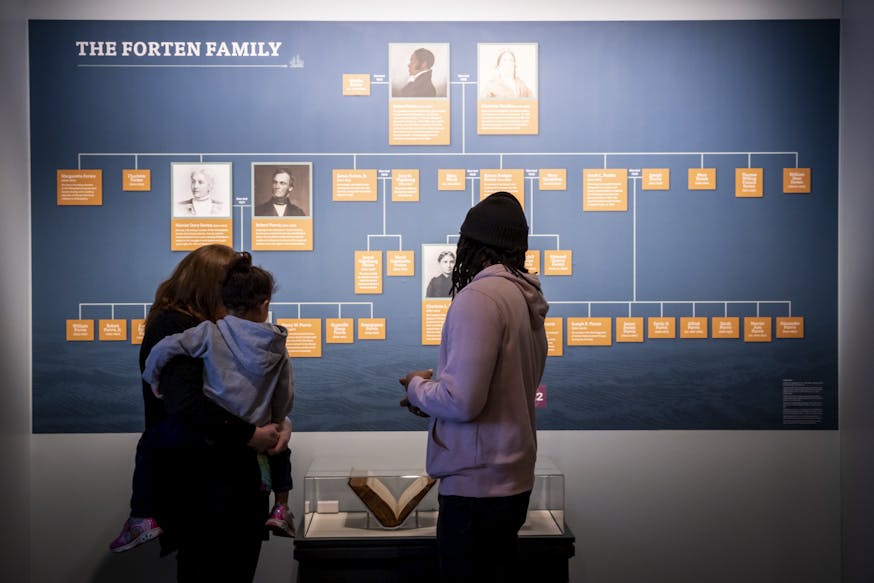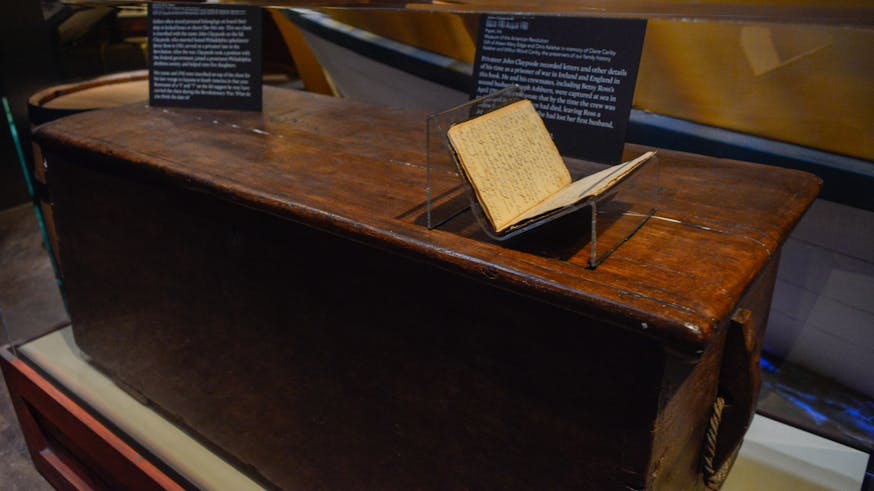News & Updates
Now on View: New Display on Betsy Ross, James Forten, and American Memory
December 8, 2023
How do we remember people from the past? Many families pass their history from generation to generation through storytelling, family heirlooms, and written documents.
As the living memory of the Revolutionary era faded with time, and as the surviving members of that generation dwindled, Americans sought to stay connected to their Revolutionary heritage. The objects displayed here represent two prominent Philadelphia families whose lives were shaped by the Revolutionary era and whose descendants preserved, and continue to share, their stories.
Elizabeth Griscom Ross Ashburn Claypoole (1752-1836), popularly known as Betsy Ross, is largely remembered due to her grandchildren’s push in the 1870s to recognize her role in the creation of the iconic flag of the United States. James Forten (1766-1842), a free African American who served as a privateer in the Revolutionary War, devoted his life to reform efforts, notably the abolition of slavery. Forten’s descendants carried on his legacy as a civil rights leader.
Take a closer look below at objects that are now on display in the Suzanne and Norman Cohn Exhibition Case in the final gallery of the Museum's core exhibition.
“Betsy Ross” Flags
Museum of the American Revolution, gift in memory of Janis Sayre Downs (left) & Museum of the American Revolution (right)

Betsy Ross’s granddaughter, Rachel Jones Wilson Albright (1812-1905), and her great-granddaughter, Sarah Markley Wilson (1840-1921), made these flags. Rachel and Sarah sold souvenir flags from the east wing of Independence Hall between 1895 and 1912. Funds from the sale of these flags supported the preservation of 239 Arch Street, known today as the Betsy Ross House.
Flags with 13 five-pointed stars arranged in a circle are still recognized today as “Betsy Ross” flags. While Rachel and Sarah presented the design as the one that their relative created in 1776, no documentation from that period supports their claim. The production and sale of these souvenir flags, however, made Betsy Ross a household name.
Five-Pointed Star Note
Museum of the American Revolution

Rachel Jones Wilson Albright and Sarah Markley Wilson, Betsy Ross’s granddaughter and great-granddaughter, often included notes like this one with the flags they sold as souvenirs. In this note, Sarah describes the alleged meeting between Ross and George Washington in 1776. When asked to design a flag with white stars, a blue canton (upper left corner), and alternating red and white stripes, Ross reportedly showed General Washington how five-pointed stars would be easier and faster to reproduce. Sarah’s note includes a pattern for Ross’s five-pointed star.
Claypoole Family Bible
Museum of the American Revolution, gift of Aileen Mary Edge and Chris Keleher in memory of Claire Canby Keleher and Wilbur Wood Canby, the preservers of our family history; conservation funded by Patriotic Order of the Sons of America

Betsy Ross, then known as Elizabeth Griscom Ross Ashburn, married John Claypoole (1752-1817), her third husband, on May 8, 1783, in Philadelphia. This Bible documents the special occasion. Ross’s mother-in-law initially owned the Bible and passed it down to her son. John and Betsy recorded the birth of Ross’s first two children with her second husband, Joseph Ashburn (1750-1782), as well as the birth of their five children together on these pages.
Betsy’s daughter, Jane Claypoole Canby (1792-1873) inherited this Bible. Her descendants eventually donated it to the Museum of the American Revolution in 2021.
James Forten’s Table
On Loan from Marcus & Lorri Huey

As a prosperous owner of a sailmaking business, James Forten was able to afford goods and furniture that many other people of African descent could not. Forten purchased this fine mahogany table, likely from the shop of a Philadelphia furniture-maker, in the 1790s or early 1800s. The table has a folding top that provides more tablespace when opened. As a civil rights leader, James Forten often invited fellow reformers, such as William Lloyd Garrison and Lucretia Mott, into his home for refreshments and conversation. They may have met around this table. To date, the table has been owned by seven generations of the Forten family.
Forten Family Bible
Museum of the American Revolution, gift of Atwood “Kip” Forten Jacobs and Taylor Jacqueline Rodriguez Jacobs

Jane Vogelsang Forten (1819-1852), daughter-in-law of James Forten, received this Bible in 1839, the year of her marriage to James Forten, Jr. (born 1811). Jane and her new husband lived in New York City at the time, and they received this Bible as a gift from the congregation at the city’s St. Philip’s African Church.
Over the decades, the Bible has become a genealogical record book for the Forten family. Five generations of descendants of Jane Vogelsang Forten have added birth, marriage, and death dates into its pages. Atwood “Kip” Forten Jacobs (Jane Vogelsang Forten’s great-great-great-great-grandson) added himself and his daughter to the family record pages prior to donating the Bible to the Museum of the American Revolution in 2023.
Margaretta Forten’s Sampler
On Loan from Marcus & Lorri Huey

Margaretta Forten (1806-1875), the eldest daughter of James Forten and his wife, Charlotte Vandine Forten (1785-1884), stitched this sampler when she was 11 years old.
Making samplers helped girls learn the alphabet, needlework skills, arithmetic, and moral lessons. Margaretta’s sampler shows a traditional arrangement with alphabets, a verse, and floral motifs in a Quaker style. She may have stitched this sampler at home or in school. As an adult, Margaretta Forten had a long career as a teacher in African American schools in Philadelphia. Her sampler has descended through the Forten family along with James Forten’s table.
This display is dedicated to Aileen Mary Edge.
Learn More

Black Founders Virtual Tour

Forten Family Heirlooms on Loan from Descendants in Black Founders Exhibit
